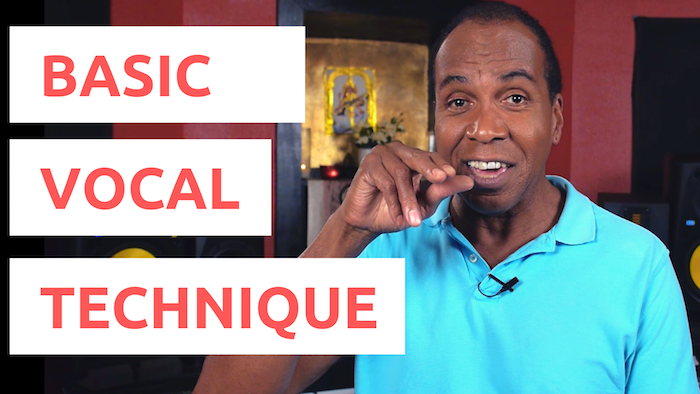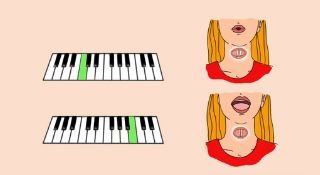Free Vocal Training To
Improve Your Singing Voice
Read on for some free vocal training. Ideas and concepts that have helped me achieve a singing voice I never thought I could ever have.
You see, I struggled for years with my voice... I bounced from teacher to teacher with no success. And when I finally DID discover how to succeed with my voice, I noticed a very strange thing!
The voice training that absolutely transformed my singing was the speech level singing method. This method, as it sounds, teaches you how to sing with the same ease as when you talk. Singing isn't exactly talking on pitch, but it is similar. Your vocal chords, as when you're talking, hold together no matter what note you are singing. Whether it is your highest or lowest note.
In past techniques that I have studied, my vocal chords always 'broke apart', forming what's known as 'the break'.
The break is the part in your voice where the chords are as tight as they can possible be... they cannot vibrate any faster. So instead, they burst apart, and you lose all your tone quality.
You 'break' into falsetto and all of a sudden, your voice lacks power.
The Secret To Star Singing
Click HERE For The Secret To Star Singing
The Secret To Star Singing
Click HERE For The Secret To Star Singing
How To Get Past The Dreaded 'Break'
As speech level singing training taught me, it is possible to erase this break entirely. So much so, that a listener won't even notice when you pass through this area in your voice.
It's like having different gears. You reach the 'breaking point', but instead of breaking, you move up a gear, and continue to sing higher.
This 'changing of gears' as I have called it is the point where your vocal chords form a new muscle coordination. This is called a 'shortened' vocal chord.
Meaning, a section of your vocal chord 'closes'.
This 'section' that is now closed, stops vibrating.
The part of the chords that is still vibrating is now shorter. This means it's easier for this shortened section to vibrate faster, making it MUCH easier to hit higher notes.
The Exercises Are Easy
The speech level singing exercises are easy. They are sounds that everyone can make. But there is genius behind them. There are powerful reasons behind the seemingly strange exercises.
They have the function of automatically zipping up your vocal chords (shortening the chords), as you sing higher. Therefore, completely eliminating the break!
And as the name implies, singing becomes as easy as talking.
The exercises take tension off the voice. They dis-engage the tension causing muscles. The ones that are designed for swallowing.
You see, lot's of singing techniques actually encourage these tension causing muscles to become involved in the singing process. This is bad news! They choke the voice, and you can never sing in your full range, or with your best tone quality.
When I began learning speech level singing exercises, I actually added an octave to my range, almost immediately. And if I can do it, I believe anyone can.
Click Here For Some Excellent Free Singing Lessons In Video Form
Basic Vocal Techniques To Get You
Started The Right Way

Let's talk about some basic vocal techniques so you can begin to sound really good.
As a voice trainer for over 30 years, here is the first lesson I give my clients.
In the video I talk about the way your vocal chords come together as you push air up through your windpipe.
If you gently sing the words "ha,ha,ha" you will feel these vocal chords come together to form the sound.
Now, while it's important to have an idea of the way your sound is being created, you won't always need to be thinking about your vocal chords when you are singing.
In fact, you rarely will!
This is just for beginning to get a feel for how your voice creates sound, and once you have the concept then you can move onto focus on other things.
To take the next step once you understand this first lesson, you can follow a singing workout that I put together that shows you all the basics and then moves into more advanced lessons here.
Creating Vocal Freedom
With the basics in place, you can begin to create more freedom in your voice.
This is important as it's what will give you more range, better tone, and more control when you sing.
Below you'll find a video where I take a client through some voice training lessons. You'll learn many tips and techniques that will help you improve quickly.
Becoming Vocally Free
In the video I’m working with a client called Aaron in a private singing lesson.
Aaron is a talented singer. He told me in an email that he struggles with over extending his voice.
“I wreck my voice when I sing”, he said to me.
Often as singers we run into this problem. As you will learn this really comes down to using the wrong muscles. This also occurs when we don’t do the correct adjustments.
Warming Up The Voice (First Vocal Warm Up Exercise)
For this exercise many of the people who watch my channel will already be familiar with this exercise. Really this exercise is the first thing I like to start with when working with anyone new to my methods and practices.
Click play below to watch (the video will begin at the correct time).
Trilling Exercise
You need to learn how to use different parts of your facial singing muscles to produce clean sounds. This will allow you to hit the notes easier and more consistently. We call this exercise a trill.
This exercise not only helps to warm up the voice but aids in limiting the amount we as singers rely on our swallowing muscles to reach the notes. This means the notes are less likely to break apart when we try to reach that higher note.
Don’t worry if you struggle with this in the beginning this isn’t something that comes easy to anyone. Just keep practicing and the techniques and it will come.
For Your First Attempt
As you can hear when Aaron started speaking he has a great deal of texture to his natural resting voice. This is a great feature to have as singers. It helps to bring emotion and feeling into your song and lets the audience connect to the material.
However, with Aaron's voice he has been highly relying on the wrong muscles to reach notes in the song.
Voice Training To Correct Your Technique
To correct this I had Aaron put his hands on his cheeks and make an exaggerated grin face and do a lip trill. This stopped him from using his swallowing muscles. It also let him draw on a different set of muscles to create sound.
Click play below to watch this. (The video will begin at the correct time).
When First Correcting Your Voice
Now this can be quite a weird sensation and will feel rather strange. Certainly Arran found it strange. In fact he told me that he sounded like Chewbacca. “Don’t worry that’s normal”, I told him. Using this exercise we can work up the scale. Exaggerating our sounds in the exercise.
Each time Aaron did this I got him to really emphasise how he did this. This starts to train the foundations for what muscles we will use to sing. Just through doing this exercise we were able to see Aaron get far higher notes than before.
The correction exercises we did was the tongue trill but first we used both our hands on our face to hold the expression. Secondly we just put out thumb under the throat to monitor the swallowing muscles.
Watch Aaron doing this tongue trill exercise by clicking play below:
Working On A Song
 The exercises will help get your voice in a great place so when you sing a song you can sound your best.
The exercises will help get your voice in a great place so when you sing a song you can sound your best.It’s one thing doing exercises. However, applying it to a song and making a connection is quite a different thing. Attempting a song after doing the exercises we covered above will allow you to breakdown what you learned and apply it to the song.
After all you’re not going to use the tongue trill as your closing piece to your set. However, doing these exercises before you sing can be a massive help for really owning your voice as you perform.
The Song Choice
In this video Aaron picked Justin Timberlake’s song “Cry Me a River” to perform. So we started with Aaron singing the song through as he normally would.
Watch Aaron's first performance by clicking play on the video below (it will begin playing at the correct time).
In the beginning I noticed that he started to slide back in his throat when singing. What I then got him to do was put his hands on his cheeks and exaggerate the sounds.
Watch this in the video below (it will begin playing at the correct time).
This helps to counteract our natural tendency to fall back in our throats. Even after doing this Aaron was able to have slightly less restriction when moving through the notes. Instead he sung using his facial mask. This made the notes easier to reach and didn’t damage the voice.
However, as I said to Aaron, in the beginning we need to fight the habit to fall back in our throats. This can be difficult in the beginning. However, practice will make it possible.
Getting Those Higher Notes
Often as singers we don’t want to be limited in our song choice. A good singer can sing in multiple genres and for multiple keys. However, it can be difficult to achieve those higher notes if we don’t use the proper signing techniques.
When working on the song with Aaron I recommended that when he started to sing the higher notes he deliberately over pronounce the words. This gets easier with time but it helps to train the brain to engage more of the facial mask for reaching these trickier notes.
Watch Aaron over pronouncing his words and see the effect it has (click play below).
Exercise For Reprogramming The Voice
Many of you will already be familiar with this exercise I got Aaron to do it in the training. The intention is to get the sound to be felt higher up in the face. As well as actively monitoring if the throat muscles are moving down.
Often exaggerating like this can make your voice sound more nasal. It can also help tilt you head forward to engage more of the facial mask and less of the swallowing muscles.
Aaron and many other people find this difficult as it is so different from how you are used to singing. However, this is what makes it such an effective exercise.
With daily training it really will create a noticeable difference in your voice.
Just listen to how Aaron sounded so much more vocally free after this exercise. (Click play below)
Falsetto
Aaron also wanted to be able to understand and use more falsetto in his signing voice. This is a method of signing, particularly for those with a lower normal range to reach higher notes. Usually I don’t recommend using too much falsetto.
Long term use of incorrect falsetto can really damage to vocal muscles. Instead I suggest using the exaggerated facial mask sounds to get the high notes but also retain some connection while singing. This will allow you to move down the notes much easier as well.
Click play below to hear my explanation.
How we deal with these tricky notes

For these higher key notes I have another great method of consistently hitting them. A lot of people start low and try to go higher to reach the notes.
However, instead of this I suggest imaging you are pulling the note down as you sing. This combined with using the facial mask allows for more consistently controlled singing (and less damage to the voice) at a higher range.
Click play on the video below to hear Aaron using this technique to get his high notes:
Nay Nay Nay exercise
At this point of the lesson I wanted to bring in the Nay Nay Nay exercise. I use this exercise to help with stopping the throat muscles activating. Using the Nay sound is a great base for understanding how to use the facial mask in creating consistent sounds.
Click play below to watch Aaron using the Nay Nay Nay exercise (the video will begin at the correct time).
Pulling it down
After doing this Aaron was able to reach a greater number of the notes in the song. However, he still was in the mindset of going up for the notes. This is understandable as the song was in such as high key and had so much energy behind it.
However, remember this important lesson; “never go up for a note”. You always need to imaging you are pulling these higher notes down closer to your normal range as you sing them. The effect of this can be significant.
As we saw in Aaron’s next attempt of the song the notes stayed together more at a higher range. All this comes down to be slightly changing the way you were saying the words.
Remember the more repetitions you do the more your body adjusts to this new way of singing.
I hope this tutorial has helped you in training your voice to sing.
Free Voice Training To Keep Improving
To get my best free voice training tips, click here.
More Free Vocal Training Lessons
How To Develop An Amazing Voice
More Free Vocal Training For Singing








